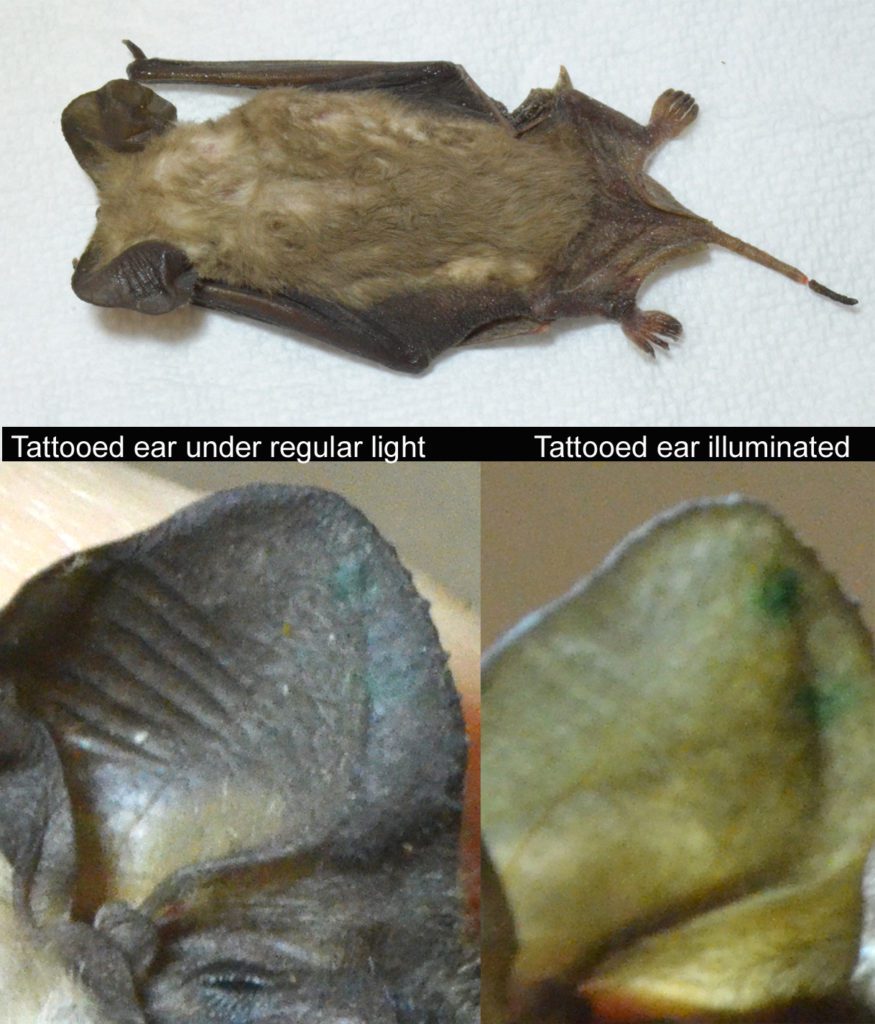By Amanda Lollar, Founder & President, Bat World Sanctuary
In the early nineties, when I was still new at rehabbing bats, the common belief was that orphaned insectivorous bats could not be released back to the wild because they wouldn’t know how to catch food (according to research, their mothers taught them). After raising several orphans to young adulthood and watching them navigate a flight cage with ease I began to question the notion that they could not be released. After all, it was instinct for these orphans to fly and it was instinct for them to echolocate, so why wouldn’t they use those two skills to find food?
The orphans were rescued from our wild sanctuary of 100,000+ free-tailed bats. I decided to release a few hand-raised flighted orphans the following summer and then track their survival. I devised a way to permanently mark them that would not be detrimental to their health (such as banding, which is highly fatal). I finally decided on a small animal tattoo gun, and I chose the the right earlobe to mark the bat. The ear was chosen because it was easily visible when the bats hang upside down from the rafters. A microbat’s ears are very small so a number system could not be used. Instead I used simple dots. Throughout the nineties the only tattoo paste I found available was black. Then, in the early 2000’s I found green ink and switched to using that. Every orphan released in 2001 had one green dot, those released in 2002 had 2 green dots, and everything from 2003 forward had 3 green dots (because there simply wasn’t enough room on their tiny ears for more dots).
Every summer, after releasing orphans, I searched on a daily basis for a tattooed ear among the tens of thousands of faces and ears in the wild sanctuary. Finally, in 2008, a couple of weeks after releasing orphans, I found one hanging from the rafters. His belly was stuffed full, but with what? Could he have found a lactating female and been lucky enough to adopted by a new mom even though he was basically a teenager? As luck would have it he pooped in my hand when I lifted him off the rafter. This was very exciting because if his poop contained insect parts then it was proof that they could indeed find food on their own. I cradled the precious “sample” in my gloved hang like a teensy nugget of gold, took it back to our facility and examined it under a microscope. Low and behold, there were dozens of insect pieces, including shiny shell fragments from beetles. Finally, proof that insect-eating orphaned bats could be released and learn to forage for insects on their own.
But then more speculation arose: okay, so orphaned bats can be released and even survive, BUT, could they survive the annual migration to Mexico and back, and even raise young of their own? That question was answered when, finally, in 2010, I spotted a beautiful, healthy, lactating female on the rafters of our wild sanctuary with three green dots on her ear. Finding her among 100,000 other bats on the rafters was akin to finding a message in a bottle, something near impossible. She appeared to be around 5 years of age and she was proof that orphaned bats can be released, survive, migrate and even raise young of their own.
Over the past 20 years we’ve received thousands of calls from the public regarding grounded and injured bats. Over all these years I have continued to check the right ear of every single bat that came in, but never saw tattoo. On Sat night, August 15, 2015, around 10:30pm we received a call about a grounded bat in the city park. The bat was hopping on the ground and couldn’t get any lift. The caller had placed the bat into a box and called us right away. After we were back at the facility I had a chance to thoroughly examine the bat. She appeared old and seemed very tired, she had mites covering her wing membrane and her tail was injured. She has been grounded for a while because she was very thin. After hydrating her I did my usual check of the right ear and my jar dropped. There they were – two faded but magnificent green dots on her right ear. That meant she was saved as a starving orphan the summer of 2002, and she was now 13 years old. It took her a little while, but I could tell she slowly started to recognize her surroundings; the roosting pouches, the sounds of the other bats in rehab, and then finally the food, which she gratefully ate. She even nuzzled my finger when I stroked her tiny face after she ate.
The following morning I immediately went to check on her. Sadly, when I removed her from a roosting pouch I could tell she was dying. She passed away a few seconds later, in the same hands that saved her some 13 years ago. I am showing these photos after she died because she should be remembered for all she did during her lifetime. This beautiful, ragged little soul migrated over 30,000 miles on her way to and from Mexico every single year, she likely raised 6 to 8 youngsters of her own, and she ate an estimated 23,725,000 insect pests during her lifetime. And lastly, she is beyond a shadow of a doubt, 100% proof positive that orphaned insectivorous bats can indeed be released to live the rich, full lives they deserve.


